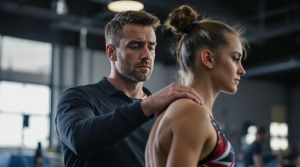Strong Spines, Strong Futures
Cheer, Dance and Gymnastics
FREE On-Demand Webinar: Spot the Signs of Scoliosis in
Cheer, Dance, and Gymnastics

Scoliosis can Impact Performance
Scoliosis affects 2-3% of teens - that’s one person in a squad.
The physical demands of cheer, dance, and gymnastics may increase the risk of progression due to the intense flexibility, strength, and repetitive spinal movements required in the sport.
Our team is highly trained to work with coaches and instructors to keep athletes and performers at their best while navigating their scoliosis treatment journey.
Call us today if you’re concerned about your teen.
Coaches and Parents can help spot early signs of scoliosis
Recognizing early signs of scoliosis, such as changes in posture or body alignment, is crucial for keeping your athlete on track.
You may also notice certain movements don’t look quite right, and may be quite uneven. Scoliosis can make a heel stretch pull sideways, a back walkover crooked or a beam dismount unstable.
It’s important to screen regularly to catch any signs early.
Watch our free webinar to learn how to spot the early signs of scoliosis in cheer, dance, and gymnastics.
Early Treatment = Better Outcomes
Proactive care is essential to preventing scoliosis from impacting an athlete’s performance.
Our expert team, with extensive experience in cheer, dance, and gymnastics, provides personalized care - from early detection to treatment - helping athletes keep performing at their best.
Get in touch today to discuss options with our team.

Scoliosis 101: What Every Coach, Parent, Athlete Needs to Know
Spot the Signs of Scoliosis in Cheer, Dance, and Gymnastics
In just 10 minutes, this On-Demand Webinar gives coaches, parents, athletes and performers the tools to spot early signs of scoliosis, know when to act, and support their athletes in staying healthy and strong.
With expert advice and easy-to-follow tips, this webinar helps ensure your athletes stay on track without letting scoliosis sideline them.
Watch now and be empowered to make a difference!
Frequently Asked Questions About Scoliosis in Cheer, Dance and Gymnastics
Can athletes with scoliosis continue competing?
Yes, many athletes with scoliosis can continue to compete with the right scoliosis-specific care. Early detection, individualized treatment by a professional trained in scoliosis management, and thoughtful adjustments to training can help athletes stay active and perform safely at a high level.
How often should athletes be screened for scoliosis?
It’s recommended that athletes undergo regular scoliosis screenings—particularly during periods of rapid growth and when participating in physically demanding sports like cheer, dance, and gymnastics. These screenings should be performed by a professional trained in scoliosis assessment to ensure early, accurate identification and timely intervention if needed.
Can your clinic help with both early detection and long-term care?
Absolutely! At ScoliCare East Phoenix Arizona, we specialize in scoliosis-specific care. Our clinic provides comprehensive screenings for early detection and develops personalized, evidence-based treatment plans managed by professionals trained in scoliosis care—supporting athletes throughout every stage of their journey.
How can I tell if my athlete has scoliosis?
Common signs of scoliosis include uneven shoulders or hips, a visible curve in the spine, or a rotated ribcage. If you observe any of these signs, it’s essential to consult a professional trained in scoliosis evaluation for an accurate assessment and appropriate next steps.
How does scoliosis affect athletes in cheer, dance, and gymnastics?
Scoliosis can impact performance by contributing to pain, reduced flexibility, and imbalances in strength and coordination. In physically demanding sports like cheer, dance, and gymnastics—where flexibility, symmetry, and control are key—existing spinal curves may become more noticeable and, in some cases, may progress without proper management. That’s why athletes with scoliosis benefit from care provided by professionals trained specifically in scoliosis assessment and treatment.
